Coloring Hair
by Elizabeth Whisson
Learn tips for coloring hair with depth and detail, using principles that can be applied to any coloring medium.
Supplies
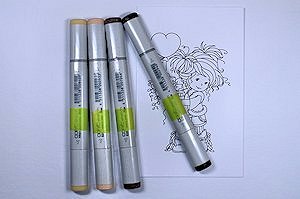
- Smooth cardstock (X-Press It blending card used here)
- Printed digital stamp or rubber stamp image stamped with dye ink (Whimsy Stamps digital stamp used here)
- At least 3 markers – light, medium and dark (four Copic alcohol markers used here)
- Other supplies as needed to complete the project (stamps, cardstock, trim, adhesive)
Step-by-Step
-
Step 1
Print or stamp a line image onto smooth cardstock. Use a dye ink for stamping any image you are going to color with alcohol markers. Memento brand is recommended.
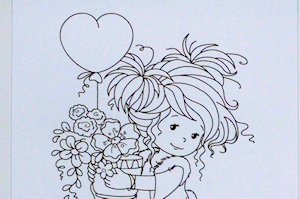
-
Step 2 (Optional)
Print or stamp the image again onto another piece of cardstock – this image will be used for determining shadow placement.
Choose a dark marker and mark all the places where the shadows will be in the hair. This will be areas near the crown and tips of the hair, and anywhere the hair is behind another piece of hair or other object (cast shadows). Hair is also darkest (deepest shadows) where it bunches together, like in a ponytail or plait.
You may then wish to take a light colored marker and mark in the highlight areas. This image can then be used as a shadow guide.
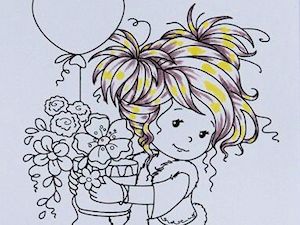
-
Step 3
If only using one image, or after determining shades/highlights on the sample image:
Take one of the lightest colored markers (E21 used here). Using the tip of the marker, flick out the color from all the shadow areas towards the highlight area. Don’t go too far into the highlight area. Add any cast shadows. This is now your guide for adding the shadows in the next step.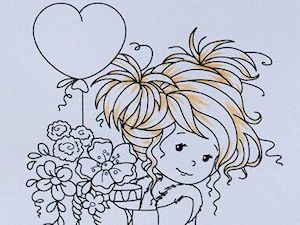
-
Step 4
Take your darkest marker (E49 used here) and, using the optional image or the strokes made with the lightest colored marker in the previous step as a guide, flick the color from the shadow area towards the highlight area. Hold the marker upright and use only the tip to achieve finer strokes. Leave small gaps between your strokes but ensure each stroke originates from the shadow area. Follow the curve of the hair or artist drawn lines.
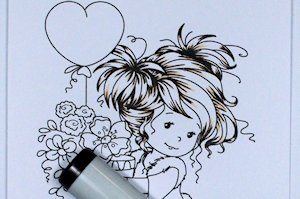
-
Step 5
Take the next lightest marker (E25 used here) and flick the color from the shadow area towards the highlight area but go a little further into the highlight area, past the end of the darkest color that you added in the previous step. Generally follow the flicks already made with the darkest marker, but you can add some extra flicks too.
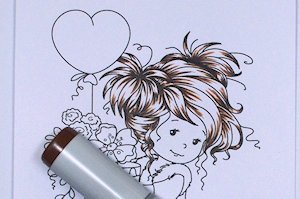
-
Step 6
Take the next lightest marker (E21 used here) and continue as for the previous markers, flicking the color further still into the highlight area. You will notice some white sections were left all the way into the shadow area. This breaks up the shadows a little so it is not all one block of color.

-
Step 7
Take the lightest marker (YR31 used here) and fill in the rest of the white area. Do not blend the colors but continue to flick the color in as before.
HINT:
If you prefer you can leave small amounts of white space for highlights to add contrast.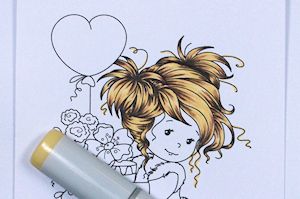
-
Step 8
Because you’ve been flicking lighter colors over darker colors, the dark colors can become lighter. Repeat steps 3 to 6 to deepen the shadows.
NOTE:
You don’t need to add as much color the second time around – ensure not to lighten the dark colors again. When repeating Steps 3 to 6, you don’t have to follow the exact flicks you did before.
-
Step 9
Finish coloring your image and add it to a card or project.
HINT:
When coloring people it is best to start by coloring the skin, as skin is usually a lighter color than the hair. Coloring the skin after the hair can cause the darker hair colors to bleed into the skin area during coloring.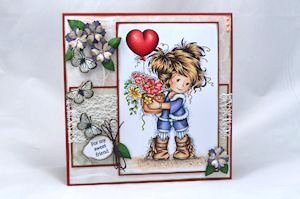
Video!
Variations
-
Instead of alcohol markers, use another coloring medium, such as paint or pencils.
Your Turn
You've seen the tutorial, now you try it! We've got a section of the gallery set aside for Coloring Hair. Try this technique, then upload your artwork to the gallery. Show us your creations!
***Please note - Internet Explorer/Edge is not a supported browser, and will not allow you to see the videos. Please use Chrome, Firefox or Safari to view our tutorial videos.
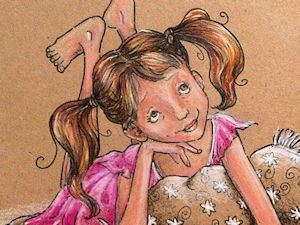

Questions and Comments
We'd love to get your feedback or questions. Leave your comment below.
Thank you again.
Mary Kay
Page 1 of 2 pages 1 2 >